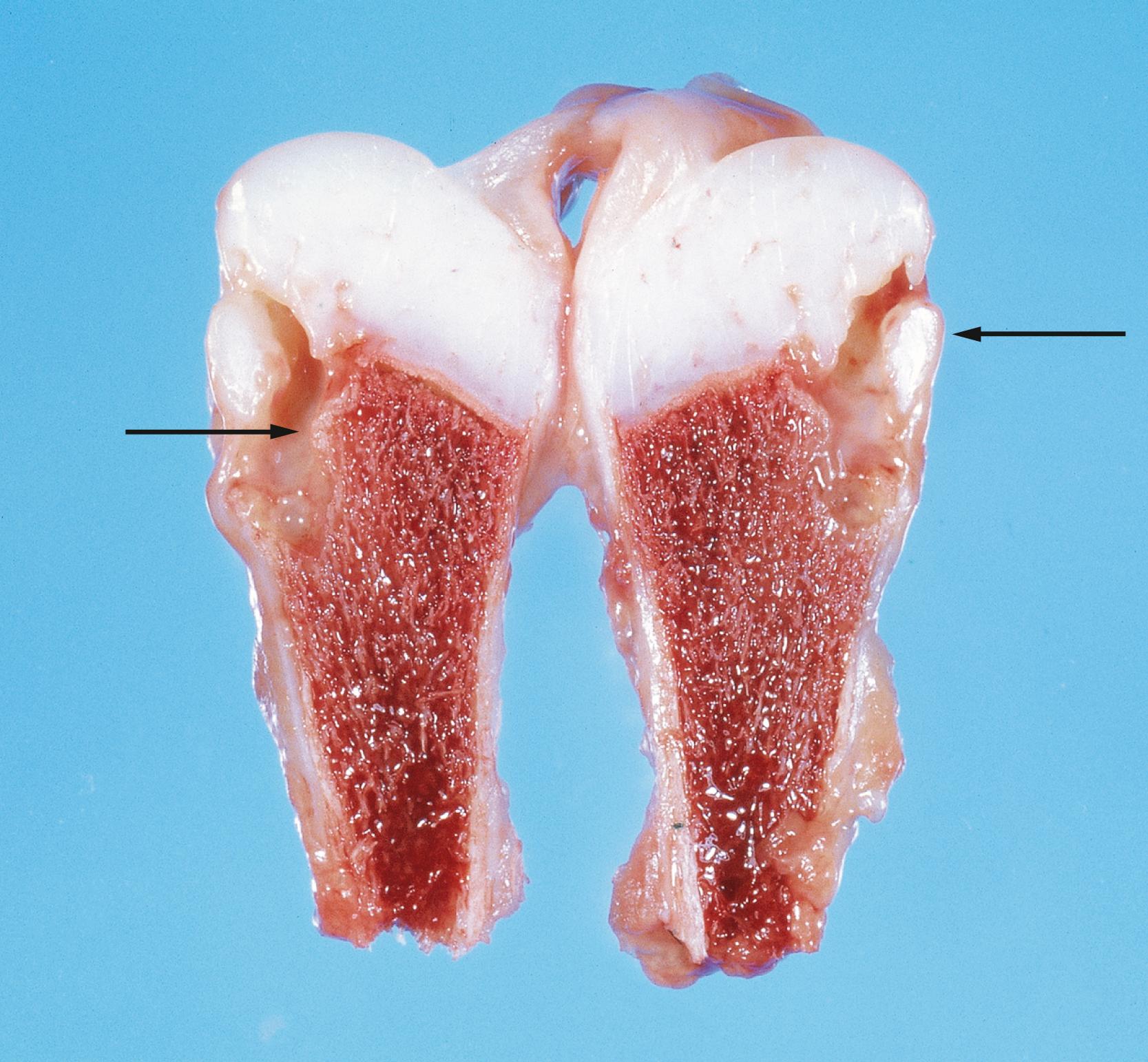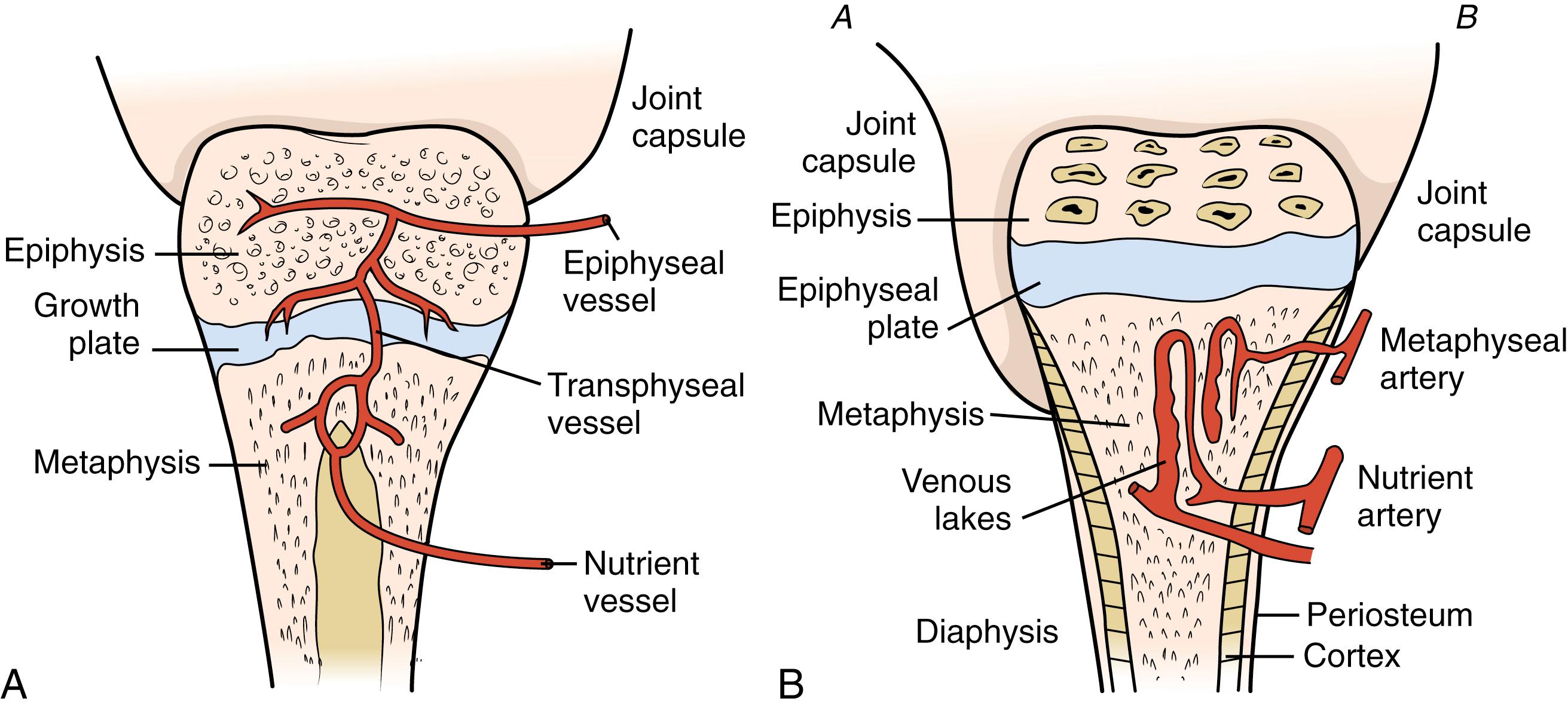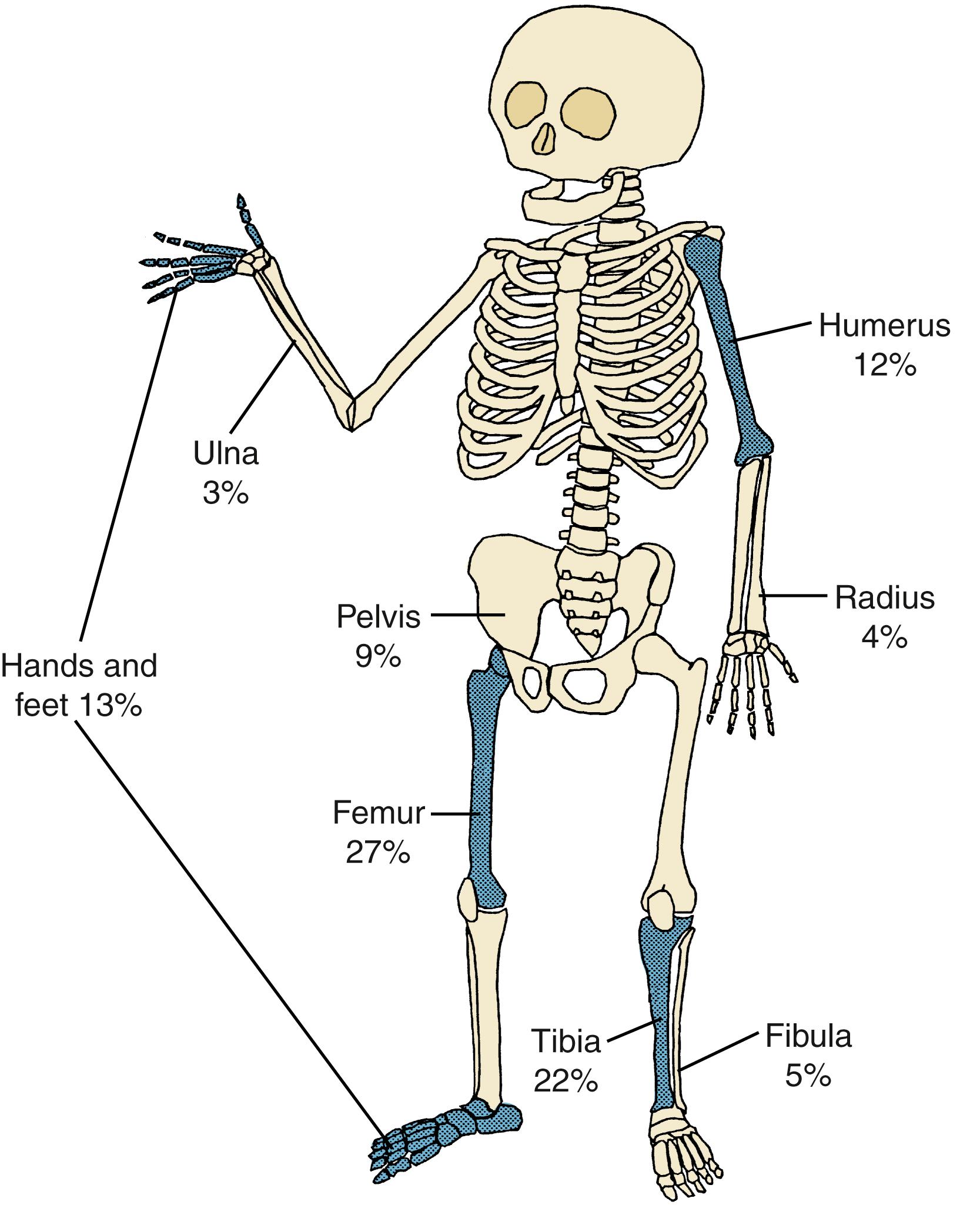Physical Address
304 North Cardinal St.
Dorchester Center, MA 02124
Osteomyelitis is inflammation of bone. It is usually caused by bacteria but occasionally by fungi. Osteomyelitis in children has a mainly hematogenous origin; less commonly, it occurs as a result of trauma, surgery, or spread from infected contiguous soft tissue. Osteomyelitis due to vascular insufficiency is rare in children.
Acute hematogenous osteomyelitis (AHO) is primarily a disease of young children, presumably because of the rich vascular supply of their rapidly growing bones. Infecting organisms enter the bone through the nutrient artery and then travel to the metaphyseal capillary loops, where they are deposited, replicate, and initiate an inflammatory response ( Fig. 75.1 ). Metaphyseal localization results from sluggish blood flow, endothelial gaps in the tips of growing metaphyseal vessels, and lack of phagocytic cells lining the capillaries. Bacteria proliferate, spread through vascular tunnels, and are anchored to areas of exposed cartilaginous matrix. Large colonies of bacteria surrounded by glycocalyx obstruct capillary lumens, impairing phagocytosis and antibiotic penetration.

Age-related differences in the anatomy of the bone and its blood supply influence the clinical manifestations of osteomyelitis. , The transphyseal vessels, found in most children <18 months, provide a vascular connection between the metaphysis and the epiphysis ( Fig. 75.2A ). In infants, infection originating in the metaphysis can spread to the epiphysis and joint space. The risk for ischemic damage to the growth plate is greater in the young infant with osteomyelitis. Before puberty, the periosteum is not firmly anchored to underlying bone. Infection in the metaphysis of a bone can spread to perforate the bony cortex, causing subperiosteal elevation and extension into surrounding soft tissue. Bony destruction also can spread to the diaphysis. By the age of 2 years, the cartilaginous growth plate usually prevents extension of infection to the epiphysis and into the joint space. When the metaphysis of the proximal femur or humerus is involved, however, infection can extend into the hip or shoulder joint at any age because the metaphysis is intracapsular at these sites (see Fig. 75.2B ).

Histologic features of acute osteomyelitis include localized suppuration and abscess formation, with subsequent infarction and necrosis of bone. Segments of bone that lose blood supply and become separated from viable bone are called sequestra. An involucrum is a layer of living bone surrounding dead bone. A Brodie abscess is a subacute, well-demarcated focal infection, usually in the metaphysis but sometimes in the diaphysis of bone.
Approximately one-half of all cases of AHO occur in the first 5 years of life. Boys are affected twice as frequently as girls, except in the first year of life. , One-third of patients have minor trauma to the affected extremity antecedent to infection, but the specific importance of this history is unclear because virtually all young children experience frequent mild trauma.
The relative risk for developing osteomyelitis appears to be higher in some populations. In New Zealand, incidence of osteomyelitis is significantly higher in Polynesian and Maori children with higher rates of complicated osteomyelitis with Staphylococcus aureus compared with other children in the same community. , It is unclear whether genetic, socioeconomic, or environmental factors account for this difference.
S. aureus is the most common cause of AHO. , , Kingella kingae, Streptococcus pneumoniae, and S. pyogenes are the organisms isolated in most other children . (See also chapters for specific pathogens.) K. kingae and S. pneumoniae infections occur most commonly in children <3 years of age. S. pneumoniae accounts for a relatively small proportion of infections, especially in the context of widespread immunization with the pneumococcal conjugate vaccine. , K. kingae has been associated with small outbreaks of bone and joint infections in childcare centers. , Coagulase-negative staphylococci (CoNS; almost exclusively as a complication of medical intervention), enteric gram-negative bacilli, and anaerobic bacteria are uncommon etiologic agents.
Bartonella henselae can cause granulomatous infection of bone. Actinomyces spp. cause facial and cervical osteomyelitis. Infection with Serratia spp. and Aspergillus spp. should be considered in children with chronic granulomatous disease.
Before widespread use of Haemophilus influenzae type b (Hib) conjugate vaccine, Hib was the cause of 10%–15% of cases of osteomyelitis in children <3 years. , Hib is a rare cause in immunized children.
Acute osteomyelitis due to community-acquired methicillin-resistant Staphylococcus aureus (CA-MRSA) has become common. Some CA-MRSA isolates causing osteoarticular infection carry the genes for Panton–Valentine leukocidin (PVL), a virulence factor or marker for complicated infections. ,
Most patients with AHO have symptoms for <2 weeks before they are brought to medical attention, although a small proportion have low-grade fever and intermittent bone pain for several weeks. , The most common manifestations are fever, pain at the site of infection, and reluctance to use an affected extremity. , Less common complaints are anorexia, malaise, and vomiting. Physical findings consist of focal swelling, tenderness, warmth, and erythema (usually over the metaphysis of a long bone). Rarely, a draining fistulous tract develops over the affected bone.
Persistent tenderness during treatment of presumed soft tissue infection or cellulitis can be a clue to osteomyelitis. Exaggerated immobility of the joint and lack of point tenderness over the bony metaphysis suggest pyogenic arthritis. Other causes of bone pain are fracture, bone infarction secondary to hemoglobinopathy, leukemia, vitamin deficiency, and bony neoplasms such as metastatic neuroblastoma and Ewing sarcoma.
Osteomyelitis most frequently occurs in the long bones ( Fig. 75.3 ), although in some series, 10%–25% of cases involve short or nontubular flat bones, including the pelvis, vertebrae, clavicle, calcaneus, skull, ribs, and scapula. , , Multiple bones are involved in about 5% of cases.

Compared with methicillin-sensitive S. aureus (MSSA), patients with MRSA infections have more protracted courses of fever, prolonged hospitalization, multiple foci of infection, pyomyositis, and subperiosteal and intraosseous abscesses. , Patients with PVL-positive CA-MRSA are at increased risk for deep-vein thrombosis or septic emboli to the lungs. , , PVL-positive isolates have not been associated with an increased likelihood of causing bone and joint infections. There have been variable findings on whether or not PVL-positive isolates are associated with increased orthopedic complications including development of chronic osteomyelitis. ,
Bacteriologic diagnosis can be confirmed in 50%–80% of cases of AHO; bacteriologic confirmation is optimized when multiple specimens, including blood, bone, and joint fluid, are sampled. , , , , , Cultures obtained by imaging-guided bone biopsy are more likely to be positive if larger volumes (>2 mL) of purulent material are aspirated. Diagnosis of K. kingae infection is enhanced with intraoperative inoculation of culture material directly into liquid media or onto agar plates. The use of real-time polymerase chain reaction (PCR) testing has greatly enhanced the ability to detect pathogens if the patient received antibiotics before obtaining cultures and for poorly cultivatable pathogens such as K. kingae .
The erythrocyte sedimentation rate (ESR) is elevated in up to 90% of cases of osteomyelitis, and the C-reactive protein (CRP) level in 98%. , , , The mean ESR is 40–60 mm/hr, but levels >100 mm/hr can occur. ESR generally peaks 3–5 days after initiation of therapy and returns to normal in approximately 3 weeks. CRP levels peak by the second day (mean, 8.3 mg/dL) and return to normal (<2.0 mg/dL) after approximately 1 week of therapy. Patients infected with PVL-positive versus PVL-negative S. aureus are more likely to have positive blood cultures and higher ESR and CRP levels at presentation. Higher levels of CRP at diagnosis may predict greater risk of sequelae. The peripheral white blood cell count can be elevated or normal. Thrombocytosis can be remarkable, especially when symptoms exist for >1 week and persist during treatment.
Radiographic abnormalities in osteomyelitis reflect inflammation of soft tissue and destruction and new formation of bone. , , The earliest abnormalities, seen within the first 3 days of onset of symptoms, are deep soft tissue swelling and loss of the normally visible tissue planes around the affected bone. Osteopenia or osteolytic lesions from destruction of bone usually are not visible until approximately 50% of bone has been demineralized. Lytic lesions, periosteal elevation due to subcortical purulence, and periosteal new bone formation appear approximately 10–20 days after onset of symptoms. Sclerosis of bone is seen when infection has been present for longer than a month. If deep soft tissue swelling is seen on plain radiograph in a patient with a short history of symptoms and with point tenderness over the affected metaphysis, no further imaging studies are necessary to support the diagnosis of osteomyelitis.
MRI is the most accurate way to diagnose osteomyelitis and offers enhanced sensitivity compared with plain radiographs and radionucleotide scanning. , The reported sensitivity of MRI for detection of osteomyelitis ranges from 92%–100%.
Normal red and fatty portions of the bone marrow have a characteristic appearance on MRI. Fatty marrow produces a bright signal on T 1 -weighted images. Changes in marrow caused by infection and inflammation produce an area of low signal intensity within the bright fatty marrow. Areas of low signal intensity in infected marrow seen on a T 1 -weighted image are expected to show bright signal intensity on a T 2 -weighted image. These changes are not specific for osteomyelitis and can be seen with malignancy, fracture, and bone infarction.
MRI can detect signal alterations in soft tissue and is particularly useful in differentiating cellulitis from osteomyelitis. MRI also may differentiate acute from chronic osteomyelitis. Gadolinium-enhanced MRI can be particularly useful in the diagnosis of soft tissue, muscle, or bone abscesses. Further, the use of gadolinium contrast agent can increase confidence in the diagnosis of osteomyelitis. MRI has been used to identify bone marrow infection in cases of B. henselae infection, particularly when plain films and CT of the affected bones are normal.
Become a Clinical Tree membership for Full access and enjoy Unlimited articles
If you are a member. Log in here